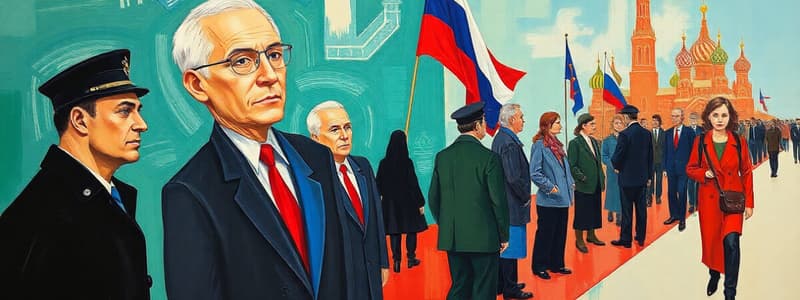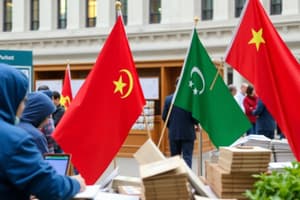Podcast
Questions and Answers
Which of the following best describes the primary goal of price liberalization during Russia's transition to a market economy?
Which of the following best describes the primary goal of price liberalization during Russia's transition to a market economy?
- To ensure all citizens had equal access to essential goods at affordable prices.
- To maintain fixed prices while introducing a parallel market for luxury goods.
- To gradually increase state control over pricing to stabilize the economy.
- To eliminate shortages and establish market-based prices for goods and services. (correct)
What was a significant, direct consequence of the hyperinflation that resulted from price liberalization in Russia during the 1990s?
What was a significant, direct consequence of the hyperinflation that resulted from price liberalization in Russia during the 1990s?
- Erosion of savings and incomes, particularly affecting the elderly. (correct)
- A surge in personal savings and investment in the stock market.
- Increased foreign investment due to lower relative prices.
- A strengthening of the ruble against major international currencies.
Which of the following describes 'insider privatization' as it occurred in Russia during the transition to a market economy?
Which of the following describes 'insider privatization' as it occurred in Russia during the transition to a market economy?
- The transfer of state assets to private ownership managed by government-appointed trustees.
- The acquisition of ownership of enterprises by their managers and workers at favorable prices. (correct)
- The distribution of state-owned assets to foreign investors to attract capital.
- The sale of state-owned enterprises through public auctions to the highest bidders.
Why was the privatization process in Russia during the 1990s considered controversial?
Why was the privatization process in Russia during the 1990s considered controversial?
What was the intended purpose of trade liberalization as part of Russia's economic reforms?
What was the intended purpose of trade liberalization as part of Russia's economic reforms?
What was a notable, adverse effect of trade liberalization on some sectors of the Russian economy?
What was a notable, adverse effect of trade liberalization on some sectors of the Russian economy?
What was the primary goal of the financial stabilization measures implemented in Russia during its economic transition?
What was the primary goal of the financial stabilization measures implemented in Russia during its economic transition?
Which of the following social consequences was a result of Russia's transition to a market economy?
Which of the following social consequences was a result of Russia's transition to a market economy?
Which factor most significantly contributed to widespread social unrest during Russia's economic transition in the 1990s?
Which factor most significantly contributed to widespread social unrest during Russia's economic transition in the 1990s?
What was a major criticism of the privatization process during Russia's economic reforms?
What was a major criticism of the privatization process during Russia's economic reforms?
How did the economic reforms impact Russia's manufacturing sector?
How did the economic reforms impact Russia's manufacturing sector?
What was the primary economic consequence of hyperinflation in Russia during the 1990s?
What was the primary economic consequence of hyperinflation in Russia during the 1990s?
What contributed most to the rise of oligarchs in post-Soviet Russia?
What contributed most to the rise of oligarchs in post-Soviet Russia?
What long-term economic challenge emerged as a result of Russia's transition to a market economy?
What long-term economic challenge emerged as a result of Russia's transition to a market economy?
What was a significant political consequence of widespread corruption in post-Soviet Russia?
What was a significant political consequence of widespread corruption in post-Soviet Russia?
What was one of the POSITIVE results of Russia's transition to a market economy?
What was one of the POSITIVE results of Russia's transition to a market economy?
Which approach to economic reform was suggested as an alternative to the 'shock therapy' method used in Russia?
Which approach to economic reform was suggested as an alternative to the 'shock therapy' method used in Russia?
What characterizes the legacy of Russia's economic transition in the early 1990s?
What characterizes the legacy of Russia's economic transition in the early 1990s?
Flashcards
Market Economy Transition
Market Economy Transition
Shift from a centrally planned economy to one driven by market forces (supply and demand).
Soviet Planned Economy
Soviet Planned Economy
State controlled all property and production, with no market influence.
Price Liberalization
Price Liberalization
Removing state control over prices, allowing them to be set by supply and demand.
Privatization
Privatization
Signup and view all the flashcards
Voucher Privatization
Voucher Privatization
Signup and view all the flashcards
Insider Privatization
Insider Privatization
Signup and view all the flashcards
Trade Liberalization
Trade Liberalization
Signup and view all the flashcards
Financial Stabilization
Financial Stabilization
Signup and view all the flashcards
Hyperinflation
Hyperinflation
Signup and view all the flashcards
Capital Flight
Capital Flight
Signup and view all the flashcards
Rise of Oligarchs
Rise of Oligarchs
Signup and view all the flashcards
Market Economy
Market Economy
Signup and view all the flashcards
Transition Shock
Transition Shock
Signup and view all the flashcards
Social Safety Nets
Social Safety Nets
Signup and view all the flashcards
Resource Dependence
Resource Dependence
Signup and view all the flashcards
Economic Decline
Economic Decline
Signup and view all the flashcards
Weakening of State Institutions
Weakening of State Institutions
Signup and view all the flashcards
Study Notes
- Russia's transition to a market economy in the 1990s was complex and controversial, marked by both opportunities and challenges.
- The reforms aimed to replace the Soviet planned economy with a market-based system.
Initial Conditions
- The Soviet economy was characterized by state ownership, centralized planning, and a lack of market mechanisms.
- Shortages of goods, inefficient production, and technological backwardness were prevalent.
- The political system was authoritarian, with the Communist Party controlling all aspects of life.
Key Reforms
- Price liberalization: Prices were freed from state control, leading to a sharp increase in inflation.
- Privatization: State-owned enterprises were transferred to private ownership through various methods, including voucher privatization.
- Trade liberalization: Restrictions on foreign trade were removed, opening the Russian economy to international competition.
- Financial stabilization: Measures were taken to reduce inflation and stabilize the ruble.
Price Liberalization
- Aimed to eliminate shortages and create market-based prices.
- Led to hyperinflation in the early 1990s, eroding savings and incomes.
- Many people were unprepared for the sudden price increases
- The elderly and those on fixed incomes were particularly hard hit.
Privatization
- Designed to transfer state assets to private hands and promote economic efficiency.
- Voucher privatization involved distributing vouchers to citizens, which could be used to purchase shares in privatized enterprises.
- Insider privatization allowed managers and workers to acquire ownership of their enterprises at bargain prices.
- Controversial due to allegations of corruption, asset stripping, and unfair distribution of wealth.
- Led to the emergence of a new class of wealthy oligarchs who controlled significant parts of the economy.
Trade Liberalization
- Aimed to integrate Russia into the global economy and promote competition.
- Increased the availability of goods and services but also exposed domestic industries to foreign competition.
- Some industries struggled to compete, leading to job losses and economic hardship in certain regions.
Financial Stabilization
- Implemented to reduce inflation and stabilize the ruble.
- Involved tight monetary policy and fiscal austerity measures.
- Helped to bring inflation under control but also led to a decline in output and investment.
Social Consequences
- Increased inequality: The gap between the rich and poor widened significantly during the transition period.
- Poverty: Millions of people fell into poverty as a result of economic restructuring and inflation.
- Unemployment: Many state-owned enterprises closed down, resulting in widespread job losses.
- Social unrest: Protests and strikes occurred due to economic hardship and dissatisfaction with the reforms.
- Decline in social services: Funding for healthcare, education, and other social services was reduced.
Political Consequences
- Rise of oligarchs: Wealthy individuals gained significant political influence.
- Corruption: Became widespread, undermining the rule of law and public trust.
- Political instability: Frequent changes in government and political infighting.
- Weakening of state institutions: The capacity of the state to regulate the economy and provide public services was diminished.
Economic Outcomes
- Decline in output: The Russian economy experienced a sharp decline in output in the early 1990s.
- Hyperinflation: Inflation reached extremely high levels, eroding savings and incomes.
- Capital flight: Large amounts of capital flowed out of the country.
- Dependence on natural resources: The Russian economy became heavily reliant on exports of oil and gas.
- Limited diversification: The manufacturing sector remained underdeveloped.
Criticisms of the Reforms
- Too rapid: The reforms were implemented too quickly, without adequate preparation or social safety nets.
- Lack of transparency: Privatization was often conducted in a non-transparent manner, leading to corruption and unfair outcomes.
- Failure to protect vulnerable groups: Insufficient attention was paid to the social consequences of the reforms.
- Excessive focus on macroeconomic stabilization: Other important aspects of economic development, such as institutional reform and infrastructure investment, were neglected.
Positive Aspects of the Reforms
- Creation of a market economy: The reforms laid the foundation for a market-based system, which has the potential to promote economic growth and efficiency.
- Increased choice and availability of goods: Consumers benefited from a wider range of goods and services.
- Greater economic freedom: Individuals and businesses had more freedom to make their own decisions.
- Integration into the global economy: Russia became more integrated into the global economy, which facilitated trade and investment.
Alternative Perspectives
- Gradualism: Some economists argued that a more gradual approach to reform would have been less disruptive and more equitable.
- Stronger state role: Others believed that the state should have played a more active role in guiding the transition and protecting vulnerable groups.
- Focus on institutional reform: Some argued that institutional reforms, such as strengthening property rights and the rule of law, were more important than privatization.
Conclusion
- Russia's transition to a market economy was a complex and difficult process with both positive and negative consequences.
- The reforms transformed the Russian economy and society but also created new challenges, such as inequality, corruption, and dependence on natural resources.
- The legacy of the transition continues to shape Russia's economic and political development.
Studying That Suits You
Use AI to generate personalized quizzes and flashcards to suit your learning preferences.




